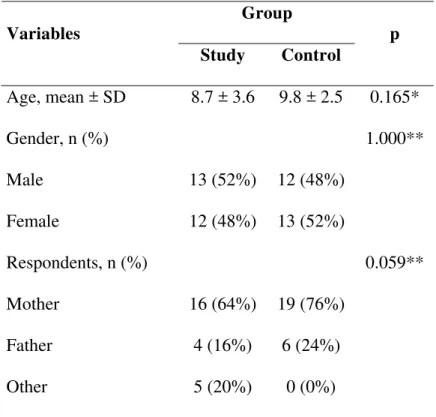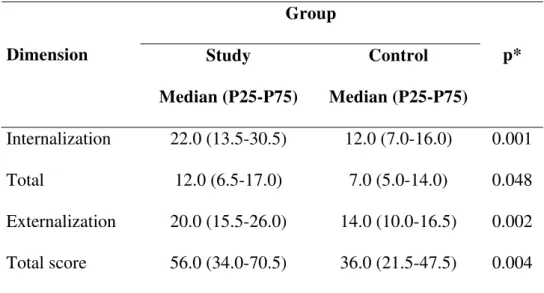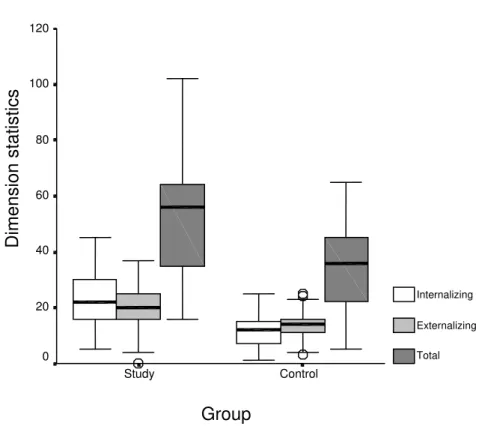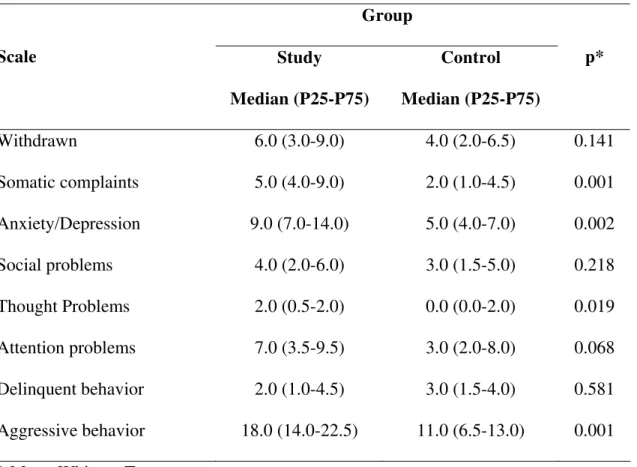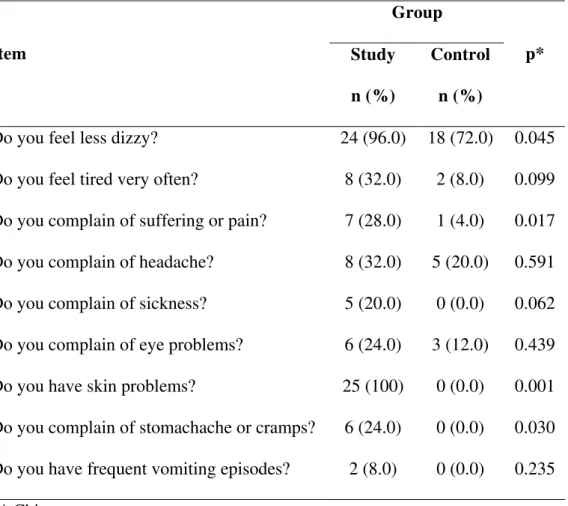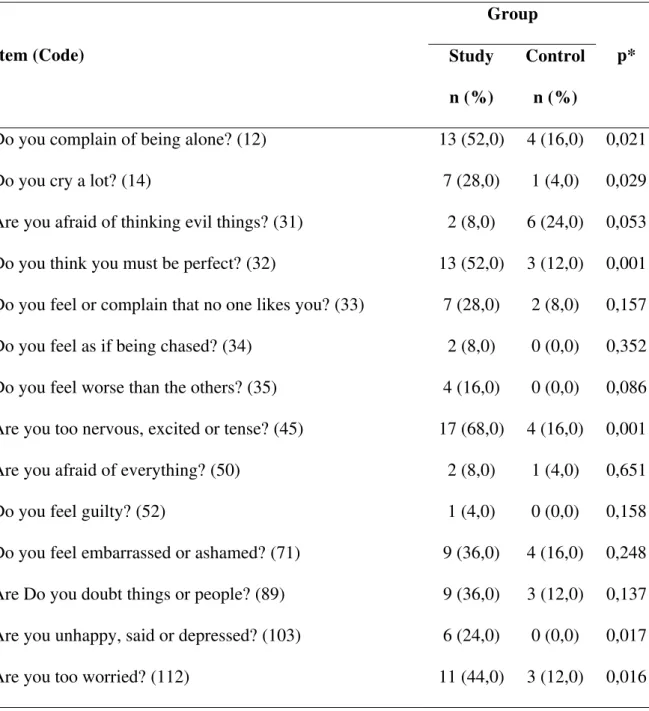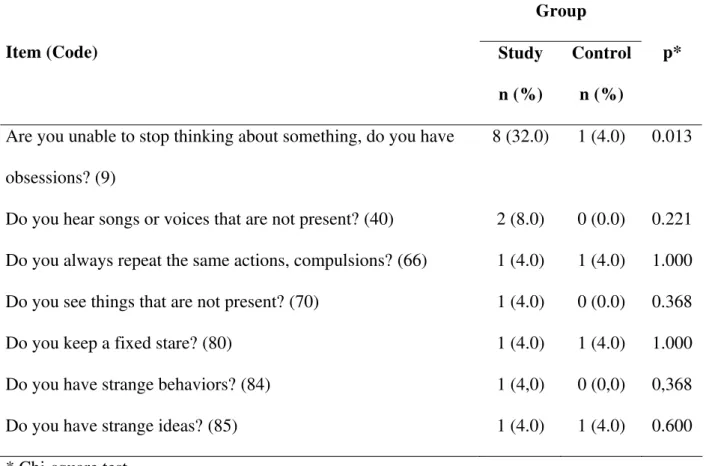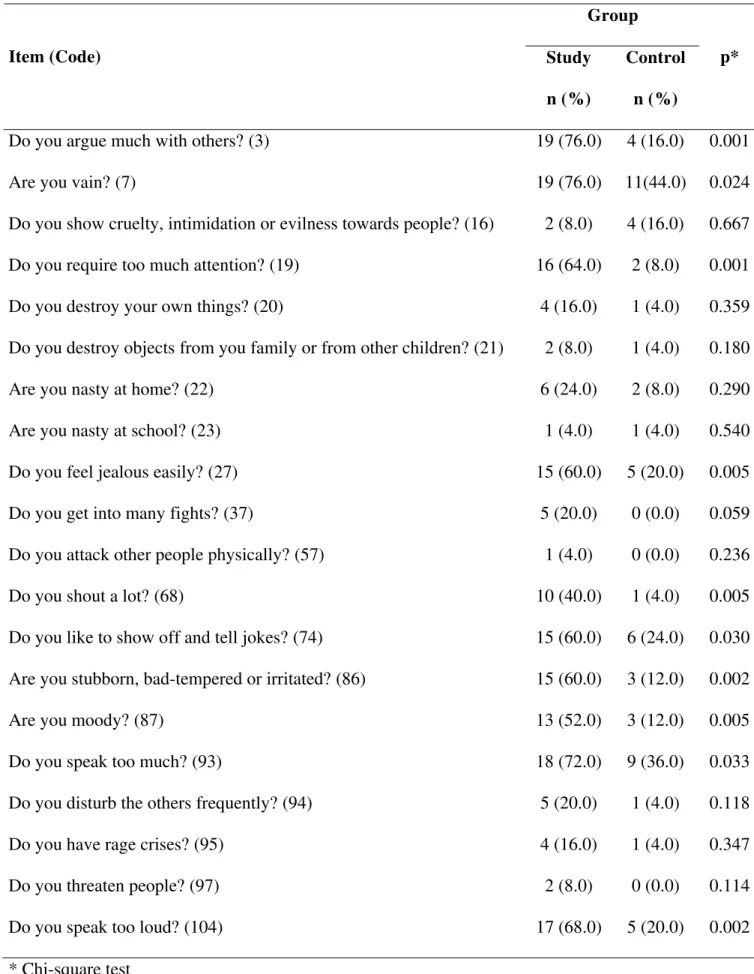Original article
Evaluation of emotional and behavioral symptoms in children and adolescents with atopic dermatitis
Paulo T. L. Fontes Neto* Magda B. Weber** Suzana D. Fortes*** Tânia F. Cestari**** Gabriela Fortes Escobar†
Nicolle Mazotti† Bruna Barzenski†† Tatiana Laufer da Silva†††
Mariana Soirefmann†††† Clarissa Pratti††††
* Physician, Psychiatry specialization. M.Sc. student, Post-Graduate Program (Medical Sciences): Pediatrician, Universidade Federal do Rio Grande do Sul (UFRGS), Porto Alegre, RS, Brazil. E-mail: paite@terra.com.br.
** Dermatologist physician. Professor – M.Sc., Medical School, Universidade Luterana do Brasil (ULBRA), Canoas, RS, Brazil. E-mail: mbw@terra.com.br.
*** Psychiatrist Physician. Psychoanalist, SPPA. Ph.D. (Public Health), University of Illinois, Chicago, USA. Fellow in Infant and Adolescent Psychiatry, Medical College of Wisconsin, Milwaukee, Wisconsin, USA. E-mail: mbw@terra.com.br.
† Medical Student, UFRGS, Porto Alegre, RS, Brazil.
†† Medical Student, Universidade de Caxias do Sul (UCS), RS, Brazil. ††† Resident (Psychiatry), UFRGS, Porto Alegre, RS, Brazil.
†††† Specialization Student (Dermatology), UFRGS, Porto Alegre, RS, Brazil.
INTRODUCTION
Among the several functions of the human skin, it protects the organism against
environment aggressions and allows for essential physiological changes. Besides, it constitutes the boundaries of the body, presenting the individual to the others and to the world. Through the skin it is possible to show desires and early sufferings, which in many cases have not been symbolized yet.1
Many of emotional manifestations are easily realized, such as, for example, to pale with fright, to blush with shyness, to sweat or shiver in scaring situations. However, there are several information about processes and physical reactions related to skin diseases that have not been fully understood yet.2 Within the universe of representations, the atopic dermatitis (AD) is an illness with an evident relation between psychic suffering and somatic manifestations.3,4
The AD is common among children and has recurrent episodes in different periods of life. The chronic course, the intensity of the symptoms and the discomfort caused by the disease cause serious implications to the patient’s and his family. More severe clinical conditions may even make it difficult for the patient to fit school, social and familial norms.5-8 Regardless of the disease severity, the AD has a strong influence on patients’ life quality, because it interferes in their daily leisure, work and study activities.9
Studies showing the importance of the emotional component in the etiology and progress of the AD have been published.3,4,10 Champion & Parish, in 1994, highlighted that adult patients with AD generally have severe psychological manifestations during childhood.5
As to the disease development and emotional factors, a study by Davison et al., in 2000, emphasizes that patients that understand this relation feel more comfortable when talking to friends, relatives and professionals because they become more self-confident.11
In order to try to understand which emotional factors could interfere in the disease
aggressiveness, dependence, sensitivity, emotional liability, hyperactivity, difficulty in expressing feelings, sexual conflicts, masochism, high intelligence level, shyness and being doubtful.12-14
Hashiro & Okumura, in 1997, performed a study focusing on psychosomatic symptoms in patients with AD. They identified that these patients are more depressive than normal controls and they also tended to be more prone to develop psychosomatic symptoms, which suggests they need dermatological and psychiatric treatment.15
Another important factor to be considered is concerned to the impact that the disease has on the patient’s family life. In 2002, Terreehorst et al. mentioned in their work the influence of
families, since most part of the patients have other concomitant diseases, such as allergic rhinitis, asthma and insomnia. These comorbidities worsen the family situation.16
As to financial matters, also related to the impact the disease has on families, Kemp highlighted a significant psychological and financial stress, particularly in cases of children with more severe AD. Moreover, these children are more prone to develop other organic problems, such as allergies to food, changes in development, intestinal allergies, asthma and allergic rhinitis. Kemp emphasizes that more comprehensive therapies should be employed to comprise all difficulties of such a complex disease.17
Studies using standardized psychological instruments did not found significant emotional differences between children with and without atopy.18 Controversy among studies is because some authors try to determine a specific type of personality in patients with atopic dermatitis, and others do not consider such possibility. There is, however, a consensus that there is an emotional
component in AD manifestations.3,4,18
With the objective of assessing the emotional characteristics of children, mental health care professionals that treat children must have a normal development reference point to analyze and identify the kind of behavior that may indicate emotional disorders.19
requires the professional to pay attention to the characteristics of the development phases and, at the same time, to environmental changes. The professional must be aware that the symptoms during childhood are not stable, they can change according to social structure and life conditions (Carmichael, 1975, apud Souza).19 Understanding the human development has been the task of many researchers, based on the presuppose that “each phase is a product from the interaction with the environment and from the biological forces that work in the organisms.”19
In 1996, Bee shares the same opinion in another study, highlighting that in order to explain consistency and change in child’s development it is necessary to explore nature and environment, biology and culture, understanding how the individual interacts with these factors. The result of this interaction may demonstrate if the children is physically and mentally healthy. The child is a living system within other systems (family, school, society). As it grows, the context changes and
therefore other challenges arise, which the child shall overcome, learn with them and show different abilities to fit a new environment. When the child is able to follow and respond to these
environmental changes adequately, it can be considered a competent child.20
According to Masten & Coastsworth,21 competence is influenced by the child’s capabilities and by the nature of the context where she lives, being the result of the complex interaction between the child and the environment. A child is competent when she or he is able to perform a task in a given environment, which is in accordance with their age range, gender and cultural, social and family context. For example, a child ranging from 10 to 12 years-old must be able to follow social rules, to develop academic activities (read, write, etc.), to make friends and to be accepted by his or her classmates.21
These authors, however, have also demonstrated that some children, when exposed to a risky situation, may have their development impaired. But there are those that, in the same situation, show to be competent, developing abilities to overcome such drawbacks.21,22 What could be
Rutter, in 1987, called “resilience” this capacity of responding positively to stress, it means “the capacity of recovering and maintaining an adequate behavior after some kind of damage.”22 Resilience can be both in the individual and in the social context, varying according to the child’s development phase.23
Pesce et al., in 2004, made a study with the objective of analyzing the resilience relation with unfavorable life events and protection factors. They assessed 997 school-age adolescents from the public network in São Gonçalo, a town in the state of Rio de Janeiro, Brazil. They concluded that negative life events were not related to resilience, but protection factors showed to have some correlation. They pointed out that adolescents with higher resilience levels had higher self-esteem, good family supervision, good interpersonal relationship and good social support (emotional, affective and informative).24
In order to identify possible vulnerability of children exposed to risk situations, or the variables that have been protecting these children, making them resilient, professionals from the children mental health care area may use some assessment instruments. However, care is required in the accomplishment of such evaluation tool, especially in what concerns the instrument, application guidelines, standardization for Brazilian children, intended goals and professional qualification.
Currently, one of the most used instruments for the assessment of emotional and behavioral symptoms in children and adolescents (4-18 years) is the Child Behavior Checklist (CBCL). Such inventory has proven efficacy in research studies. It is also used in services of mental health as a screening tool to differentiate individuals with psychopathologies and normal ones.25
The CBCL has already been translated to 55 idioms. In Brazil it was validated as Inventário
de Comportamentos da Infância e Adolescência, and has good reliability, even with children from
different cultures.26,27
It is composed of 138 items, divided into two blocks. The first one has 20 items related to social competence (sports, leisure, friends, participation in groups, school development,
fathers/carers compare their kids’ behavior with other children’s the same age, defining them as below, above or within the mean. Comparisons requested are related to time dedicated to different activities, degree of participation in groups, quality of familial relationship, independence to play or to work and school performance.25,28
The second CBCL block is composed of eight different scales, which amount for a total of 118 items about emotional and behavioral symptomatology, answered by parents/care givers. It has a 3-point ranging behavior: not true (score = 0); somewhat or sometimes true (score = 1); and very true or often true (score = 2).25,28
The eight specific scales are: I. withdrawn; II. somatic complaints; III. anxious/depressed; IV. social problems; V. thought problems; VI. attention problems; VII. delinquent behavior; e VIII. aggressive behavior. They make possible to obtain the total score of all scales scores together and the individual scores of each scale.Another possibility is to obtain three partial scores, which correspond to the scales considered together and sub-divided into: internalizing scales (I, II e III), total problems scale (IV, V e VI) and externalizing scales (VII e VIII).25,28
The goal of the present study is to assess the presence of emotional and behavioral
symptoms in a group of children with AD, which are treated in the Dermatology Outpatient Clinic of Hospital de Clínicas de Porto Alegre (Serviço de Dermatologia - HCPA), Rio Grande do Sul state, Brazil, and to compare them against another group of children with visible symptoms,
composed of students from the public education network in the city of Porto Alegre (RS), submitted to the same evaluation. We believe that the clinical effect of this study will be the implementation of existing psychotherapeutic techniques, with the goal of focusing on symptoms found, making possible to provide a more comprehensive approach to the disease.
METHOD
selected, and their respective parents/care givers among patients treated in the Dermatology Outpatient Clinic at HCPA; the control group (CG) was composed of 25 children, enrolled in a public school in Porto Alegre (RS), randomly selected from different grades. Groups were paired by age (4-16 years old), gender, socioeconomic conditions and survey respondents (father, mother and others). The calculus of the sample size was estimated with a confidence interval of 95%, with 90% power and standardized effect size, which account for a total of 50 children, 25 in each group. As inclusion criteria for the SG we considered: child or adolescent from 4 to 16 years old; AD diagnosed by specialists; informed consent signed by parents/responsible care givers. For the CG, inclusion criteria were: child or adolescent from 4 to 16 years old; student at the Escola Estadual Jerônimo de Albuquerque, Porto Alegre (RS), Brazil; without AD and not under treatment for any dermatological disease or asthma; informed consent signed by parents/responsible care giver.
Exclusion criteria for both groups were non-agreement to enter the study and not being accompanied with their care giver. All participants agreed with the study and signed the free and informed consent.
Even though the CBCL was designed to be a self-applicable instrument, in the present study the scale was used in a private interview, because families had low schooling, as described in the validation to the Brazilian context.27 Interviews were performed in the Dermatology Outpatient Clinic at HCPA with the SG and at school in the CG.
The sample was characterized through descriptive statistics, using mean, median, minimum, maximum, standard deviation, 25th and 75th percentiles and absolute and relative frequencies for the qualitative variables, in the comparison between groups. For the age variable we used the Student’s
The study was approved by the Research Ethics Committee from HCPA, under the protocol number 03-271.
RESULTS
Data were collected from December 2003 to December 2004. The total sample comprised 50 children whose main features are shown in Table 1. Groups were paired for age, gender and respondents, as the shown in the statistical analysis. As to parents’ profession, the group was shown to be very homogenous, children belonged to social classes C and D.
Table 1 - Sample features of both groups of children Group
Variables
Study Control p
Age, mean ± SD 8.7 ± 3.6 9.8 ± 2.5 0.165*
Gender, n (%) 1.000**
Male 13 (52%) 12 (48%)
Female 12 (48%) 13 (52%)
Respondents, n (%) 0.059**
Mother 16 (64%) 19 (76%)
Father 4 (16%) 6 (24%)
Other 5 (20%) 0 (0%)
* Student’s t-test ** Chi-square test
Social competence
Social competences were assessed through three criteria: activities performed, social
activities developed by children, this means they are less involved in activities than the CG children (Table 2).
Table 2 - Scores of social competences compared between groups
Group
Social Competence Study
Median (P25-P75)
Control Median (P25-P75)
p*
Activities 2.5 (2.0-4.0) 5.0 (3.0-6.5) 0.002
Social 5.0 (3.5-6.0) 5.5 (4.5-7.0) 0.113
School 4.3 (3.1-5.8) 5.0 (4.0-5.0) 0.425
* Mann-Whitney Test
Total and dimension scores
The CBCL dimensions assess groups globally. The results show statistically significant differences in all dimensions; the SG had socio-behavioral changes as compared to the CG (see Table 3).
Table 3 - Total and Dimension scores compared between groups Group
Dimension Study
Median (P25-P75)
Control Median (P25-P75)
p*
Internalization 22.0 (13.5-30.5) 12.0 (7.0-16.0) 0.001 Total 12.0 (6.5-17.0) 7.0 (5.0-14.0) 0.048
The graph with the comparisons between dimensions demonstrates a sharp difference between medians of groups in each dimension (Figure 1).
Figure 1 - CBCL Dimensions according to each group of children
Individual scores in each scale
Table 4 shows the total outcome of each scale in each group, and the result of the statistical test obtained with the comparison of results among groups. There was statistical significant
difference between groups in the scales of somatic complaints, anxiety/depression, thought problems and aggressive behavior. In the SG, values were significantly higher than in the CG.
Group
Control Study
Dimension statistics
120
100
80
60
40
20
0
Internalizing
Externalizing
Table 4 - Individual scores in each scale
Group
Scale Study
Median (P25-P75)
Control Median (P25-P75)
p*
Withdrawn 6.0 (3.0-9.0) 4.0 (2.0-6.5) 0.141
Somatic complaints 5.0 (4.0-9.0) 2.0 (1.0-4.5) 0.001 Anxiety/Depression 9.0 (7.0-14.0) 5.0 (4.0-7.0) 0.002
Social problems 4.0 (2.0-6.0) 3.0 (1.5-5.0) 0.218
Thought Problems 2.0 (0.5-2.0) 0.0 (0.0-2.0) 0.019
Attention problems 7.0 (3.5-9.5) 3.0 (2.0-8.0) 0.068
Delinquent behavior 2.0 (1.0-4.5) 3.0 (1.5-4.0) 0.581
Aggressive behavior 18.0 (14.0-22.5) 11.0 (6.5-13.0) 0.001 * Mann-Whitney Test
Table 5 - Items of the somatic complaints scale and gross scores in the SG and CG
Group
Item Study
n (%)
Control n (%)
p*
Table 6 - Items of the anxiety/depression scale and gross scores in the SG and CG
Group
Item (Code) Study
n (%)
Control n (%)
p*
Do you complain of being alone? (12) 13 (52,0) 4 (16,0) 0,021
Do you cry a lot? (14) 7 (28,0) 1 (4,0) 0,029
Are you afraid of thinking evil things? (31) 2 (8,0) 6 (24,0) 0,053 Do you think you must be perfect? (32) 13 (52,0) 3 (12,0) 0,001 Do you feel or complain that no one likes you? (33) 7 (28,0) 2 (8,0) 0,157 Do you feel as if being chased? (34) 2 (8,0) 0 (0,0) 0,352 Do you feel worse than the others? (35) 4 (16,0) 0 (0,0) 0,086 Are you too nervous, excited or tense? (45) 17 (68,0) 4 (16,0) 0,001 Are you afraid of everything? (50) 2 (8,0) 1 (4,0) 0,651
Do you feel guilty? (52) 1 (4,0) 0 (0,0) 0,158
Do you feel embarrassed or ashamed? (71) 9 (36,0) 4 (16,0) 0,248 Are Do you doubt things or people? (89) 9 (36,0) 3 (12,0) 0,137 Are you unhappy, said or depressed? (103) 6 (24,0) 0 (0,0) 0,017
Are you too worried? (112) 11 (44,0) 3 (12,0) 0,016
Table 7 - Items of the thought problems scale and gross scores in the SG and CG
Group
Item (Code) Study
n (%)
Control n (%)
p*
Are you unable to stop thinking about something, do you have obsessions? (9)
8 (32.0) 1 (4.0) 0.013
Do you hear songs or voices that are not present? (40) 2 (8.0) 0 (0.0) 0.221 Do you always repeat the same actions, compulsions? (66) 1 (4.0) 1 (4.0) 1.000 Do you see things that are not present? (70) 1 (4.0) 0 (0.0) 0.368
Do you keep a fixed stare? (80) 1 (4.0) 1 (4.0) 1.000
Do you have strange behaviors? (84) 1 (4,0) 0 (0,0) 0,368
Do you have strange ideas? (85) 1 (4.0) 1 (4.0) 0.600
Table 8 - Items of the aggressive behavior scale and its gross scores in the SG and CG
Group
Item (Code) Study
n (%)
Control n (%)
p*
Do you argue much with others? (3) 19 (76.0) 4 (16.0) 0.001
Are you vain? (7) 19 (76.0) 11(44.0) 0.024
Do you show cruelty, intimidation or evilness towards people? (16) 2 (8.0) 4 (16.0) 0.667 Do you require too much attention? (19) 16 (64.0) 2 (8.0) 0.001
Do you destroy your own things? (20) 4 (16.0) 1 (4.0) 0.359
Do you destroy objects from you family or from other children? (21) 2 (8.0) 1 (4.0) 0.180
Are you nasty at home? (22) 6 (24.0) 2 (8.0) 0.290
Are you nasty at school? (23) 1 (4.0) 1 (4.0) 0.540
Do you feel jealous easily? (27) 15 (60.0) 5 (20.0) 0.005
Do you get into many fights? (37) 5 (20.0) 0 (0.0) 0.059
Do you attack other people physically? (57) 1 (4.0) 0 (0.0) 0.236
Do you shout a lot? (68) 10 (40.0) 1 (4.0) 0.005
Do you like to show off and tell jokes? (74) 15 (60.0) 6 (24.0) 0.030 Are you stubborn, bad-tempered or irritated? (86) 15 (60.0) 3 (12.0) 0.002
Are you moody? (87) 13 (52.0) 3 (12.0) 0.005
Do you speak too much? (93) 18 (72.0) 9 (36.0) 0.033
Do you disturb the others frequently? (94) 5 (20.0) 1 (4.0) 0.118
Do you have rage crises? (95) 4 (16.0) 1 (4.0) 0.347
Do you threaten people? (97) 2 (8.0) 0 (0.0) 0.114
Do you speak too loud? (104) 17 (68.0) 5 (20.0) 0.002
DISCUSSION
Some emotional and behavioral alterations were evidenced in this study that are possibly related to AD. However, some constraints were found in the development of the present study, specially related to the CBCL. As it is an instrument designed to check symptoms and to be used to screen patients, it does not allow a detailed examination of each item intended to be studied, but it indicates the presence of alterations in the researched areas.
In social competences, we found differences only in the item activities, which show that the disease carriers participate and develop less activities (playing and others) than the CG children. We understand this is an expected founding within an atopic universe. Due to the constant
stigmatization that they suffer because of symptoms, it may be more difficult to take part in activities and to keep relationships with other children. Drake et al. (2001) highlight such a reduction of social activities of AD patients considering it as one of the factors of impact on the family life.9 Sampson & Gil (1989) also mentioned such impact, highlighting the decreased participation in social activities as the result of some “practical problems” with AD.12 The item related to “activities” concerns the social competence, as previously described. The sample studied evidenced the SG children’s difficulties in the interaction with the environment, as Masten & Coatsworth suggested in 1998.21 One must not forget that this competence is influenced by temperament, a factor that can be observed in other CBCL scales as well.
when assessed specifically as to school and socializing. This fact can be understood as the influence of temperament and personality in these issues.
In the present study, the general result of the second block of CBCL showed significant differences in all dimensions (introversion and extraversion).25 Achenbach created the CBCL in 1996, and he suggested this name in order to facilitate the understanding of both dimensions. The first one, introversion,27 refers to the child’s personality and the second, extraversion,27 is related to her conduct. The sample evaluated in this study demonstrated that the SG presented differences as compared to the CG, both in personality features and conduct manifestations. For better
interpretation of this outcome, the specific scales must be observed (withdrawn, somatic
complaints, anxiety/depression, social problems, thought problems, attention problems, aggressive behavior, delinquent behavior) and discussed in separate, so that a profile of the group studied could be created.
Within the introversion dimension there are the withdrawn, somatic complaints and anxiety/depression scales.
As to withdrawn, there were no significant differences. This aspect demonstrated that both groups behaved the same way, however, this fact is believed to undergo some interference
depending on the severity and degree of dermatologic commitment at the moment. The child shows her desire to have relationships, but may encounter conflicts with personal aesthetic concerns, generating responses of repulsion because of physical appearance and decreasing interpersonal activities.
Such behavior can be understood as a consequence of internal matters. Another fact that must be taken into account is that children from the SG are patients from the Dermatology
The somatic complaints present a totally justifiable result, because all children from the SG had somatic manifestations. We highlight, however, that these children complain about pain or suffering indiscriminately, which is an accordance with the literature in what concerns dependence, sensitivity and loneliness feeling. These children want to have all the attentions on them, under all aspects.2,12 Moreover, they also develop other psychosomatic diseases, such as rhinitis, asthma, allergies and others.16,17 On the other hand, Panconesi & Hautmann, in 1997, suggested that patients with AD would be more introvert people, who internalize their problems and express their anxiety and emotional conflicts through the AD. However, this may be a “normal” reaction, as highlighted by Joyce McDougall, who claims that we tend to develop such somatic reactions when internal or external circumstances overpass our habitual psychological ways of resistance.
The specific scale of anxiety/depression presented statistical significance. In this scale, the parents’ response highlights the difficulty of their children, such as loneliness, crying a lot, having a desire of being perfect, being more nervous and irritated and showing to be unhappier and more worried, in accordance with outcomes obtained by other authors as to the presence of insecurity traits, low self-esteem and depressive traits.12,13 Hashiro & Okumura, in 1997, also found anxiety and depression symptoms associated with other psychosomatic symptoms, which they do not specify in their work.15 Such features make us think about the possibility of structuring obsessive-like character traits.
A study by Liakopoulou et al., who evaluated children with alopecia aerata, which is also considered to be a psychodermatologic disease, found the same result, this means children have more symptoms related to anxiety and depression.29
As to the behavioral profile, the following scales were analyzed.
Another important fact is highlighted by Davison et al. in 2000. They emphasized that patients who understand their disease are able to talk to friends, families and professionals more comfortably.11 Among patients of the SG, the issue mentioned above must be considered again, because all of them were part of the Dermatologic Outpatient Clinic at HCPA, which adopts the practice of explaining the disease to patients and families.
The thought problems inventory , which in this scale also covers the behavior
manifestations, showed differences only in one question. “Is he unable to stop thinking about something, does he have obsessions?” Such a result suggests that children with AD are more worried, more rigid in their thoughts of perfectionism. Such data makes us think again about the relation between AD and obsessive thought.
As to possible attention problems, no significant difference was found. Such a result may suggest a tendency that could be significant in case the sample was higher. However, we observe in the clinical practice that children with AD frequently are inattentive and hyperactive. This does not represent a nosologic entity, but symptoms related to depression and anxiety.
The dimension extraversion includes the scales of delinquent behavior and aggressive behavior.
In the evaluation of the delinquent behavior we have not found a statistically significant difference between groups, suggesting that these children do not have conduct-related disorders.
The present study tried to go further on the issue of specific behavior of AD patients, not only pointing to dimension of changed scales, but to the type of manifestation children from the SG presented, which is different from the GC children’s behavior.
As a global result of this investigation, we may say that children with AD from our sample had features in common, different from children without the disease. The socio-behavioral profile of this group was that of children with some difficulties in participating of social activities, but who wanted to. They have frequent complaints of pain and suffering, they are dependent, sensitive and have a strong need of attention. They are anxious, do not like being alone, cry a lot and think they must be perfect to please other people. Anxiety worsens due to verbalization difficulties and it is expressed through a tense, irritated behavior, with many quarrels, talking loud and being stubborn and aggressive. Such feelings may be related to itching and clinical manifestations they are submitted to. Within this profile, they are insecure, have low self-esteem, probably triggered by difficulty in handling the disease, which also may cause sudden change of mood. The association of such characteristics manifests depression traits that can become more evident when identified. They showed some features that suggested they have problems in social competence, together with low resilience.
They are young people that undergo an important psychic suffering, which must be adequately realized and investigated.
CONCLUSION
- Children with AD have less social competence than healthy children. - DA patients have more behavioral problems than healthy children.
- Children from the SG were shown to have more emotional and behavioral symptoms of anxiety and depression, insecurity, stubbornness and aggressiveness as compared to children without the disease.
FINAL CONSIDERATIONS
Many investigations have been carried out that aim at discovering the AD complexity as a psychosomatic disease, as well as its physiological, biochemical and genetic understanding. The findings of the present study show how necessary it is to approach the psychosomatic disease not only as an acute dermatologic manifestation, but also comprising the emotional components of the affected child. The understanding of emotional and behavioral issues of these patients allow for the development of more adequate and comprising therapeutic care. At the same time, the study
evidenced the need for interdisciplinary approach to patients with AD, associated with dermatologic treatment as a strategy of prevention in mental health care.
Limitations of this study are that the inventory is not able to detect diagnostic hypotheses, once it was created to assess the presence of symptoms. Future studies on the area are required, using other scales together with CBCL. This could bring more consistent information about such emotional and behavioral aspects of children with AD and support more comprehensive therapeutic actions, which would include not only the individual, but also his family and different ranges of his relationships circle.
ACKNOWLEDGMENTS
REFERENCES
1. McDougall J. Teatros do corpo: o psicossoma em psicanálise. 2ª ed. São Paulo: Martins Fontes; 1996.
2. Dethlefsen T, Dahlke R. A doença como caminho. 18ª ed. São Paulo: Cultrix; 1983. 3. Koblenzer CS. Itching and the atopic skin. J Allergy Clin Immunol. 1999;104:109-13.
4. Hashiro M, Okumura M. The relationship between the psychological and immunological sate in patients with atopic dermatitis. J Dermatol Sci. 1998;16:231-5.
5. Champion RH, Parish WE. Atopic dermatitis. In: Champion RH, Burton JL, Ebling FJG, eds. Textbook of dermatology. Oxford: Blackwell Scientific Publications; 1994. p. 589-610. 6. Arvola T, Tahvanaien A, Isolauri E. Concerns and expectations of parents with atopic infants.
Pediatr Allergy Immunol. 2000;11(3):183-8.
7. Lapidus CS, Kerr PE. Social impact of atopic dermatitis. Med Health R I. 2001;84(9):294-5. 8. Kiebert G, Sorensen SJ, Revicki D, Fagan SC, Doyle JJ, Cohen J, et al. Atopic dermatitis is
associated with a decrementing health-related quality of life. Int J Dermatol. 2002;41:151-8. 9. Drake L, Prendergast M, Maher R, Breneman D, Korman N, Satoi Y, et al. The impact of
tacrolimus ointment on health-related quality of life of adult and pediatric patients with atopic dermatitis.J Am Acad Dermatol. 2001;44(1):65-72.
10. Cole WC, Roth HL, Sachs LB. Group psychotherapy as an aid in the medical treatment of eczema. J Am Acad Dermatol. 1988;18:286-91.
11. Davison KP, Pennebaker JW, Dickerson SS. Who talks? The social psychology of illness support groups. Am Psychol. 2000;55(2):205-17.
12. Gil KM, Sampson HA. Psychological and social factors of atopic dermatitis. Allergy. 1989;44(9):84-9.
14. Gil KM, Keefe F, Sampson H, McCaskill CC, Rodin J, Crisson JE. The relationship of stress and family environment to atopic dermatitis symptoms in children. J Psychosom Res.
1987;31:673-84.
15. Hashiro M, Okumura M. Anxiety, depression and psychosomatic symptoms in patients with atopic dermatitis: comparison with normal controls and among groups of different degrees of severity. J Dermatol Sci. 1997;14:63-7.
16. Terreehorst I, Duivenvoorden HJ, Tempels-Pavlica Z, Oosting AJ, Monchy GR, Bruijnzeel-Koomen CAFM, et al. The unfavorable effect of concomitant asthma and sleeplessness due to the atopic eczema/dermatitis syndrome (AEDS) on quality of life in subjects allergic to house-dust mites. Allergy. 2002;57:919-25.
17. Kemp, AS. Cost of illness of atopic dermatitis in children – a societal perspective. Pharmacoeconomics. 2003;21(2):105-113.
18. Ring J, Darsoe U. Eczema atópico: uma doença com potencial de afetar a qualidade de vida. In: Anais do 9º Congresso da Academia Européia de Dermatologia e Venerologia, 2000, Suíça. São Paulo: Novartis; 2000.
19. Souza J. Maturidade emocional e avaliação comportamental de crianças filhas de alcoolistas [dissertação]. Ribeirão Preto: Universidade de São Paulo; 2004.
20. Bee H. A criança em desenvolvimento. 7ª ed. Porto Alegre: Artes Médicas; 1996. 21. Masten AA, Coatsworth JD. Development of competence in favorable and unfavorable
enviroments. Am Psychol. 1998;53(2):205-20.
22. Rutter M, Tuma AH, Lann I. Assessment and diagnosis in child psychopathology. New York: The Guilford Press; 1988.
23. Célia S. A capacitação da resiliência e a formação da pele psicossocial. In: Célia S. Novos olhares sobre a gestação e a criança até os 3 anos – saúde perinatal, educação e
24. Pesce RP, Assis SG, Santos N, Oliveira RVC. Risco e proteção: em busca de um equilíbrio promotor de resiliência. Psicol Teor Pesq. 2004;20(2):135-43.
25. Achenbach TM. Integrative guide for the 1991 CBCL/4-18, YSR, and TRF profiles. Burlington (VT): University of Vermont, Department of Psychiatry; 1991.
26. Alfons AM, Crijnen MD, Thomas M, Achenbach TM, Frank C, Verhulst MD. Comparisons of problems reported by parents of children in 12 cultures: total problems, externalizing, and internalizing. J Am Acad Child Adolesc Psychiatry. 1997;36(9):1269-77.
27. Bordin IAS, Mari JJ, Caeiro MF. Validação da versão brasileira do “Child Behavior Checklist”(CBCL) (Inventário de Comportamentos da Infância e Adolescência): dados preliminares. Rev ABP-APAL.1995;17(2):55-66.
28. Achenbach TM. Manual for the Child Behavior Checklist / 4-18 and 1991 profile. Burlington (VT) :University of Vermont, Department of Psychiatry; 1991.
29. Liakopoulou M, Alifieraki T, Katideniou A, Kakourou T, Tselalidou E, Tsiantis J, et al. Children with alopecia areata: psychiatric symptomatology and life events. J Am Acad Child Adolesc Psychiatry. 1997;36(5):678-84.
ABSTRACT
Introduction: Atopic dermatitis (AD) is a chronic inflammatory skin disease that has a significant impact on the patients’ quality of life due to recurrent episodes during their lives.
Considering recent studies describing the association between psychological aspects and atopic
dermatitis, it can be suggested that the search of a possible behavioral profile of children
presenting AD may be of help in the development of specific psychotherapeutic interventions as well
as it will increase knowledge on the disease.
Methodology: This research aims at evaluating the social behavior profile of children with AD compared with others without the disease. In this case-control study, two groups aged 4 to 18
been assisted at the Hospital de Clínicas de Porto Alegre (HCPA) and the control-group is
composed of children and adolescents without AD enrolled at public schools in Porto Alegre. The
estimated sample size was 25 individuals in each group. Data collection was accomplished with the
Child Behavior Cheklist (CBCL), which was validated in Brazil as Inventário de Comportamento da
Infância e Adolescência.
Results: Significant statistic differences were demonstrated in both global dimensions (internalizing and externalizing). Children with AD presented more symptoms related to anxiety,
depression, thought alterations and aggressive behavior as compared to children without the
disease.
Conclusion: The results emphasize the need of interdisciplinary approaches in treating children with AD, comprising not only the dermatological but also the emotional aspects of the
disease.
Keywords: Atopic dermatitis, behavior, children, psychosomatic.
Title: Evaluation of emotional and behavioral symptoms in children and adolescents with atopic dermatitis
Correspondence: Paulo T. L. Fontes Neto
Rua Casemiro de Abreu, 616/303 CEP 90420-000
